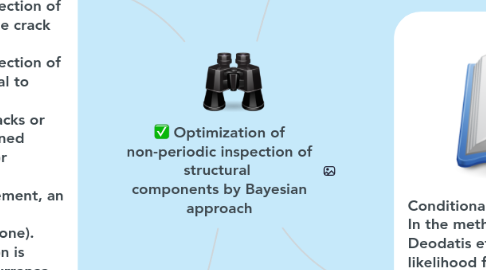Optimization of non-periodic inspection of structural components by Bayesian approach
by Isabel Zerpa

1. Basic assumptions and equations A system is considered that consists of a specific number of elements. An element is such that it possesses only one fatigue-critical location. Throughout this paper, time is measured in the number of total accumulated cycles. All elements were inspected at the initial state and at the time of each scheduled inspection. Cracks and failures that do not cause the system to stop functioning, can only be detected during inspections. The following assumptions are made: ⚫ The probability of detection of a crack is a function of the crack length. ⚫ The probability of detection of an element failure is equal to one. ⚫ When detected, all cracks or failures cause the concerned element to be repaired or replaced. ⚫ After repair or replacement, an element regains its initial strength (same as a new one). ⚫ No stress redistribution is considered after the occurrence of crack or failure.
2. Bayesian method for uncertain parameters The parameters that appear in the equations related to fatigue cracks, (2), (4) and (5), are uncertain parameters that depend on environmental conditions. In order to solve the problem of these uncertainties, a Bayesian method is applied. These parameters are modified according to the information from the inspection results.
3. This paper presents an advanced Bayesian analysis method to determine the appropriate non-periodic inspection intervals of fatigue-sensitive structures. The calculation procedure of the posterior distribution is improved compared to the previous methods.
4. Conditional probabilities In the method introduced by Deodatis et al. (1996), the likelihood function of the possible events concerning an element at the time of inspection, is determined from the historical information on all previous inspections since start-up. This determination is not possible if this information is incomplete. Using conditional probabilities, the Bayesian analysis method can solve this problem. However, the information from the time of the last repair or replacement of an element is still necessary


